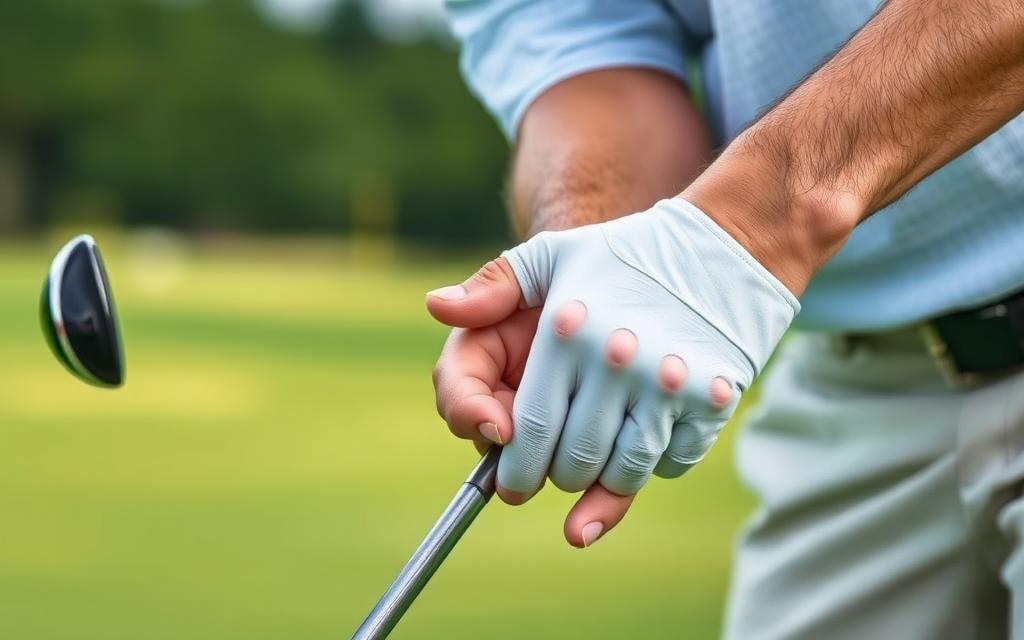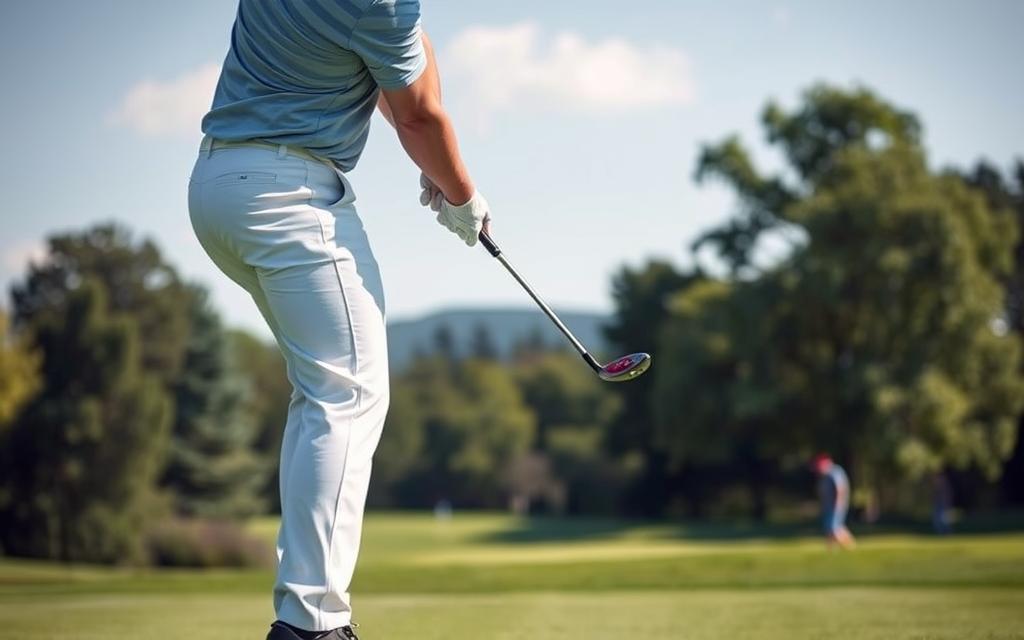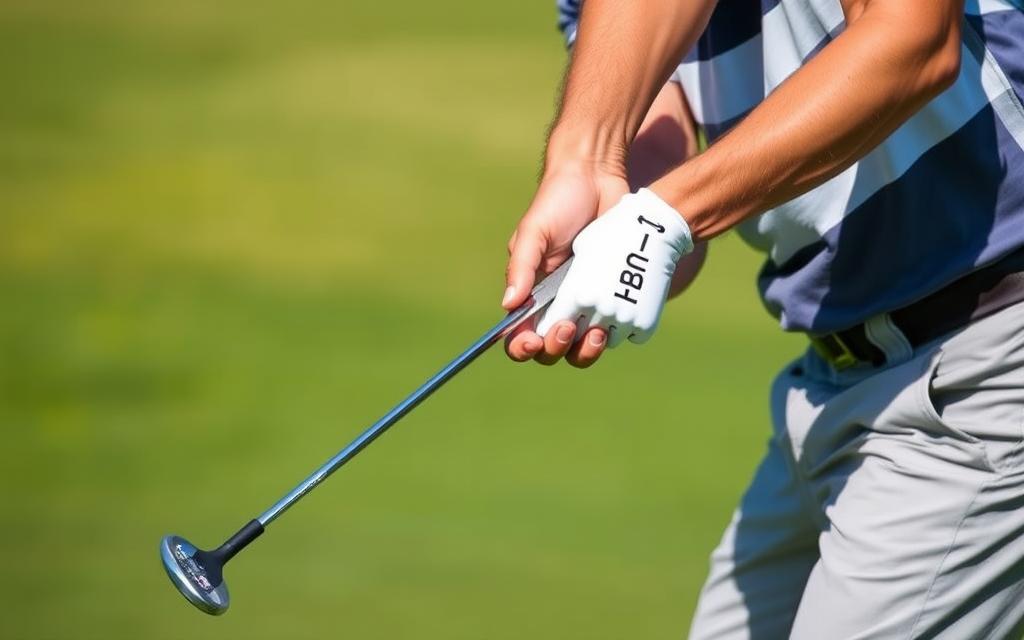Ready to take on the green, but unsure how to properly wield your golf clubs? As a beginner, the world of golf equipment can seem daunting. But fear not! This guide will unlock the secrets to using golf clubs like a pro.
From mastering the fundamentals of grip and swing to selecting the right clubs for your skill level. So, are you ready to tee off and conquer the course?
Key Takeaways
- Understand the different types of golf clubs and their purposes
- Learn proper grip techniques to improve your swing
- Develop a solid golf swing foundation with essential stance and posture tips
- Discover effective practice methods to refine your skills
- Maintain your golf clubs to ensure optimal performance
Understanding Golf Clubs and Their Types
Golf is all about knowing your clubs. Whether you’re new or experienced, learning about clubs helps a lot. We’ll look at irons, woods, and putters. You’ll see how to pick the best clubs for you.
The Differences Between Irons, Woods, and Putters
Irons are for short, precise shots. They have a low trajectory and high loft. They’re great for getting close to the hole.
Woods are for long shots. They fly high and far. They’re perfect for hitting the ball from the tee or fairway.
Putters are for the green. They help you control the ball’s speed and direction. It’s all about accuracy.
Choosing the Right Golf Clubs for Your Skill Level
Choosing the right clubs is key to playing well. Beginners should use clubs that are easy to hit. They help you learn and feel confident.
As you get better, you can use more advanced clubs. They offer better control and distance. The right clubs make your game better. Check out this guide for more info.
“Choosing the right golf clubs is not just about aesthetics; it’s about finding the perfect fit for your swing and your game.”
Knowing about irons, woods, and putters helps a lot. Picking the right clubs for your level makes golf more fun and rewarding.
Basic Grip Techniques to Improve Your Swing
A proper grip is key for a strong golf swing. Learning the basics can really improve your game. We’ll cover how to place your hands on the club and look at different grip styles.
Proper Hand Placement on the Club
How you hold the club is very important. Start by gripping the club with your dominant hand below the center. Then, overlap or interlock your other hand for a secure hold. Keep your grip firm but relaxed, guiding the club with your thumbs and forefingers.
Common Grip Styles: Overlapping vs. Interlocking
- Overlapping Grip: This grip, also called the “Vardon Grip,” places your dominant hand’s little finger between your other hand’s index and middle fingers. It helps with natural hand rotation and is good for those with smaller hands.
- Interlocking Grip: Here, your dominant hand’s little finger hooks into your other hand’s index finger. It’s great for larger hands or those wanting a unified feel in their swing.
Try both grips to see which one works best for you. The goal is to find a grip that lets you control the clubface well and play your best.

“The grip is one of the most important fundamentals in golf. It’s the foundation for a great swing.” – Tiger Woods
| Grip Style | Hand Positioning | Ideal Golfer |
|---|---|---|
| Overlapping Grip | Little finger of dominant hand between index and middle fingers of other hand | Players with smaller hands |
| Interlocking Grip | Little finger of dominant hand hooks into index finger of other hand | Players with larger hands or seeking a more unified feel |
The Fundamentals of a Good Golf Swing
Learning the basics of a good golf swing is key to improving your game. It doesn’t matter if you’re new or have been playing for years. Knowing how to stand, posture, and follow through can greatly improve your game.
Stance and Posture Essentials
Your stance and posture are vital for a smooth swing. Stand with your feet shoulder-width apart. Your weight should be evenly on your feet’s balls.
Bend a bit at the hips, keeping your back straight. Your shoulders should line up with your target. This stance helps you rotate and power your swing to hit the ball well.
The Importance of Follow-Through
- A complete follow-through is key for a consistent and accurate swing.
- Keep your stance and posture the same as you swing the club back.
- After hitting the ball, let your arms and club follow through naturally. Move your body and weight towards the target.
- A good follow-through boosts power and helps control your swing. It makes your game better.
Practicing regularly and focusing on swing basics will improve your game over time. Mastering stance, posture, and follow-through will make you more confident and skilled on the course.
“The secret of good golf is in the quiet mind.” – Gary Player

| Swing Element | Description | Benefits |
|---|---|---|
| Stance and Posture | Balanced, shoulder-width stance with weight evenly distributed. | Provides a stable base for generating power and control. |
| Follow-Through | Continuing the swing motion after ball contact, with body and weight shift. | Promotes a smooth, balanced swing and increases shot distance and accuracy. |
Tips for Practicing with Your Golf Clubs
Improving your golf game takes regular practice. Focus on iron play fundamentals, chipping and pitching, and putting tips. We’ll show you how to practice well and get better on the course.
Setting Up a Home Practice Area
Having a home practice area is a big help. Pick a spot, even a small area in your backyard. Get a practice net or mat for your swing.
Adding a putting green or chipping area is smart. It helps with your short game.
Utilizing Driving Ranges Effectively
Driving ranges are great for all golfers. Use them to practice for real game conditions. Try different iron play fundamentals and clubs.
Make sure to practice chipping and pitching too.
Incorporating Drills into Your Practice Routine
- Practice putting with short, medium, and long-range shots. This improves your control and accuracy.
- Work on your iron play fundamentals with controlled shots. Focus on hitting the ball well and controlling its flight.
- Improve your chipping and pitching by trying different shots. Practice low runners, high chips, and pitches to various distances.
Regular, focused practice is key to getting better at golf. Set up a practice area, use driving ranges well, and do specific drills. This will help you enjoy golf more and play better.
Enhancing Your Game with Golf Club Care
Proper golf club maintenance is key to bettering your game. It also helps your equipment last longer. By cleaning your clubs and knowing when to replace them, you’ll play your best.
Cleaning Your Clubs: Tools and Techniques
Keeping your golf clubs clean is easy and important. Use a soft-bristled brush and mild soap and water. Gently scrub the clubhead to remove dirt and debris.
Focus on the grooves, as they can trap dirt. This can affect your shot. After cleaning, wipe the shaft and grip with a damp cloth to make them shine.
Knowing When to Replace Worn Equipment
Even the best clubs will wear out over time. Look for signs like worn grips, damaged clubheads, or uneven wear on the club face. These signs mean it’s time for new clubs.
Getting new clubs can really boost your game. It helps you play better and reach your golfing goals.


